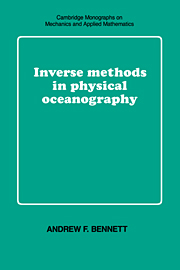Book contents
- Frontmatter
- Contents
- Preface
- 1 Finite-dimensional inverse theory
- 2 The smoothing of observations
- 3 Data assimilation
- 4 The spatial structure of the Kalman filter
- 5 Generalized inverses of dynamical models
- 6 Antenna analysis
- 7 Nonlinear quasi-geostrophic models
- 8 Open-ocean modelling: quasi-geostrophy
- 9 Primitive-equation models
- 10 Outstanding problems
- Bibliography
- Subject index
7 - Nonlinear quasi-geostrophic models
Published online by Cambridge University Press: 08 January 2010
- Frontmatter
- Contents
- Preface
- 1 Finite-dimensional inverse theory
- 2 The smoothing of observations
- 3 Data assimilation
- 4 The spatial structure of the Kalman filter
- 5 Generalized inverses of dynamical models
- 6 Antenna analysis
- 7 Nonlinear quasi-geostrophic models
- 8 Open-ocean modelling: quasi-geostrophy
- 9 Primitive-equation models
- 10 Outstanding problems
- Bibliography
- Subject index
Summary
Introduction
An essential feature of the inverse theory described in the preceding chapters has been linearity, which allows explicit expressions for the solutions of the various inverse problems. The expressions permit complete analyses of the analytical and statistical properties of the estimates. The one striking exception has been the evolution equation for the state error covariance in the Kalman filter. The equation is nonlinear, being of matrix-Riccati form, as a consequence of the requirement for a sequential approximation to the fixed-interval smoother. However, the filter estimate of the state does depend linearly on the prior estimates of forcing and initial conditions, and on the data.
The linearity of an inverse theory may be violated in many ways.
Nonlinear dynamics
The complexity of fluid motion is fundamentally due to advection, which takes a nonlinear form in the Eulerian description of flow. While there are a few classes of interesting and important oceanic motions which are adequately described by linearized dynamics, or at most linearized advection, such as tides, coastal trapped waves, equatorial interannual variability and Sverdrup flow, the importance of advection is unavoidable for most oceanic circulation. The classical examples are the western boundary currents of the subtropical gyres, the highly variable extension regions of the boundary currents, the meandering Antarctic Circumpolar Current, and equatorial mesoscale variability. The dynamics of a model may also be nonlinear as a consequence of turbulence closures expressed in terms of shear-dependent diffusivi-ties. Ocean models which include chemical tracers or biological fields may be nonlinear owing to chemical reactions, or to predation or to grazing. Only linear measurement functional have been considered thus far.
- Type
- Chapter
- Information
- Inverse Methods in Physical Oceanography , pp. 181 - 202Publisher: Cambridge University PressPrint publication year: 1992



